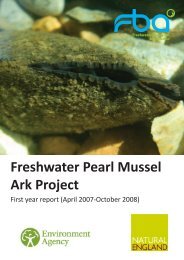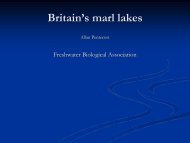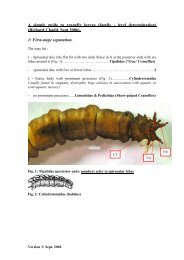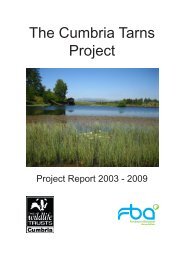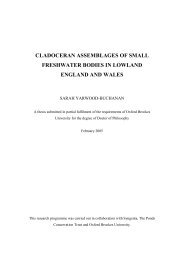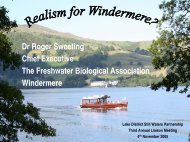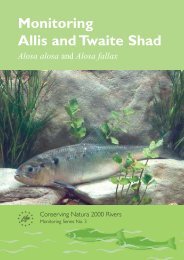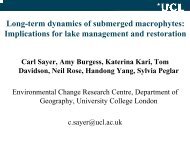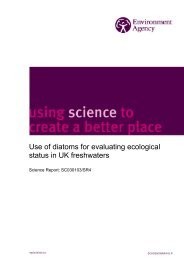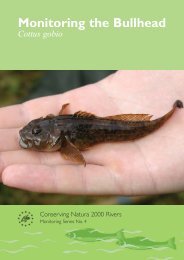Groundwater HIA post edit - FreshwaterLife
Groundwater HIA post edit - FreshwaterLife
Groundwater HIA post edit - FreshwaterLife
You also want an ePaper? Increase the reach of your titles
YUMPU automatically turns print PDFs into web optimized ePapers that Google loves.
abstraction, all assumptions must be recognised and taken into account. It is often<br />
useful to undertake some form of sensitivity analysis in order to understand the effects<br />
of ranges in parameter values on derived quantities (see Box 2.1).<br />
Box 2.1: Sensitivity analysis<br />
Example of simple sensitivity analysis to illustrate the effects of ranges in parameter values on<br />
derived quantities, using the Theis equation for unsteady-state flow in confined aquifers<br />
(Kruseman and de Ridder 1990):<br />
s = (Q/4πT).W(u)<br />
where u = r 2 S/4Tt, and W(u) is a function of u (commonly known as the well function), with s<br />
being the drawdown at a radius r from the pumping well at time t, in an aquifer of<br />
transmissivity T and storativity S, and abstraction taking place at a rate Q. Suppose that the<br />
equation is being used to predict the drawdown at a sensitive wetland, using aquifer<br />
parameters estimated from previous tests. The quantities Q, r and t are known with<br />
reasonable accuracy, and we are using estimated values of T and S to predict s. Let’s say<br />
Q = 1,000 m 3 /d, r = 500 m, t = 100 days, T = 400 m 2 /d and S = 1x10 -4 . This gives a prediction<br />
for drawdown (s) of 1.63 m. The measured range for T might be 200 to 600 m 2 /d (even<br />
ignoring the fact that the true range may be much greater), and let’s say the range for S is<br />
from 5x10 -5 to 5x10 -4 . Keeping S at the original value, using the extremes for T gives a range<br />
for s of 1.14 to 2.98 m. Keeping T at the original value, using the extremes for S gives a<br />
range for s of 1.31 to 1.77 m. However, combining the uncertainties (varying both T and S in<br />
the combinations that give the greatest extremes) results in a possible range for s of 0.93 to<br />
3.26 m. Which drawdown turns out to be the ‘true’ value could have dramatic implications for<br />
the wetland.<br />
Some types of uncertainty are easier to reduce than others. For example, drilling more<br />
observation boreholes for a pumping test, or conducting tests in several boreholes, will<br />
help to reduce the data and sample uncertainty; using a radial flow model with layers<br />
(as opposed to a simple analytical equation) to analyse the results will reduce the<br />
model uncertainty. However, reducing knowledge uncertainty may require extended<br />
scientific study; and environmental or natural uncertainty is impossible to reduce, and<br />
must just be recognised.<br />
2.3 Conceptual modelling<br />
Conceptual modelling is at the heart of both CAMS and the Water Framework Directive<br />
(see Appendix 1), and its importance to <strong>HIA</strong> cannot be overemphasised. In the water<br />
resources context, a conceptual model can be defined as a synthesis of the current<br />
understanding of how the real system behaves, based on both qualitative and<br />
quantitative analysis of the field data. Some people take the view that conceptual<br />
models are based upon a purely qualitative understanding, with quantitative<br />
assessment only coming in during subsequent analytical or numerical modelling.<br />
However, in this report, the term conceptual modelling definitely includes quantitative<br />
analysis.<br />
A real hydrogeological system is so complex that it will never be possible to study<br />
everything in detail; a conceptual model is therefore bound to be a simplification of<br />
reality. The important question is to determine what needs to be included in the study<br />
and what can be safely ignored. In other words, what observed behaviour do we want<br />
the conceptual model to get right, and what don’t we mind the model getting wrong?<br />
For example, if we are investigating the mechanisms that operate during periods of low<br />
flow in a Chalk stream, we may not mind being wrong about the mechanisms that<br />
operate during groundwater flooding events (Environment Agency 2002a). Or, when<br />
developing a regional groundwater resources model of a coastal aquifer we may<br />
choose to ignore the difference in density between fresh and saline water in order to<br />
6 Science Report – Hydrogeological impact appraisal for groundwater abstractions




